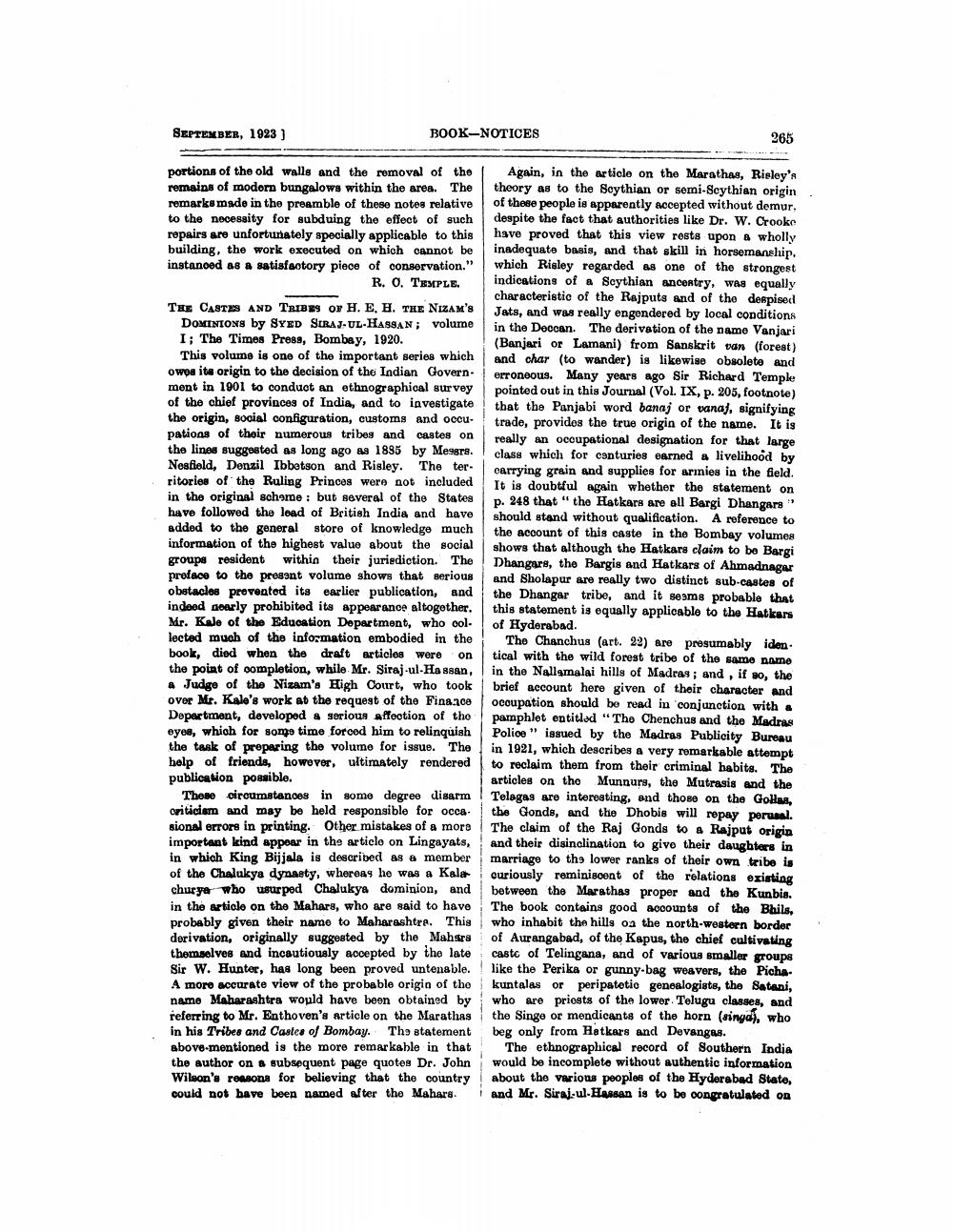________________
SEPTEMBER, 1923)
BOOK-NOTICES
265
portions of the old walls and the removal of the Again, in the article on the Marathas, Risley's remains of modorn bungalows within the area. The theory as to the Soythian or semi-Scythian origin remarks made in the preamble of these notes relative of these people is apparently accepted without demur. to the necessity for subduing the effect of such despite the fact that authorities like Dr. W. Crooke repairs are unfortunately specially applicable to this have proved that this view rests upon a wholly building, the work executed on which cannot be inadequate basis, and that skill in horsemanship. instanced as a satisfactory piece of conservation." which Risley regarded as one of the strongest
R. O. TEMPLE. indications of a Scythian ancestry, was equally
characteristic of the Rajputs and of the despised THE CASTIS AND TRIBES OF H. E, H, THE Nizam's Jats, and was really engendered by local conditions
DOMINIONS by SYED SIRAJ-UL-HASSAN; volume in the Doocan. The derivation of the name Vanjari I; The Times Press, Bombay, 1920.
(Banjari or Lamani) from Sanskrit van (forest) This volume is one of the important series which and char (to wander) is likewise obsolete and owes its origin to the decision of the Indian Govern. erroneous. Many Vears Ago Sir Richard Temnle ment in 1001 to conduct an ethnographical survey pointed out in this Journal (Vol. IX, p. 205, footnote) of the chief provinces of India, and to investigate that the Panjabi word banaj or vanaf, signifying the origin, social configuration, customs and occu- trade, provides the true origin of the name. It is pations of their numerous tribes and castes on
really an occupational designation for that large the lines suggested as long ago 49 1885 by Me9gre.
class which for centuries earned a livelihood by Nesfield, Denzil Ibbetson and Risley. The ter.
carrying grain and supplies for arinies in the field, ritories of the Ruling Princes were not included
It is doubtful again whether the statement on in the original scheme : but several of the States p. 248 that "the Hatkars are all Bargi Dhangars" have followed the lead of British India and have should stand without qualification. A reference to added to the general store of knowledge much the account of this caste in the Bombay volumes information of the highest value about the social shows that although the Hatkars claim to be Bargi groupe resident within their jurisdiction. The Dhangars, the Bargis and Hatkars of Ahmadnagar prolace to the present volume shows that serious and Sholapur are really two distinct sub-castes of obstacles provented its earlier publication, and the Dhangar tribe, and it seems probable that indood nearly prohibited its appearance altogether. this statement is equally applicable to the Hatkars Mr. Kale of the Education Department, who ool. of Hyderabad. lected much of the information embodied in the The Chanchus (art. 22) are presumably iden. book, died when the draft articles were on tical with the wild forest tribe of the same name the point of completion, while Mr. Siraj ul Hassan, in the Nallamalai hills of Madras; and, if so, the A Judge of the Nizam's High Court, who took brief account here given of their character and over Mr. Kilo's work at the request of the Finance ocoupation should be read in conjunction with a Department, developed a serious affection of the pamphlet entitled "The Chenchus and the Madras eyee, which for some time forood him to relinquish Police" issued by the Madras Publicity Bureau the task of preparing the volume for issue. Thein 1921, which describes a very romarkable attempt help of friends, however, ultimately rendered to reclaim them from their criminal habits. The publication possible.
articles on the Munnure, the Mutrasis and the These circumstances in some degree disarm ! Telagas are interesting, and those on the Golas, criticism and may be held responsible for occa- the Gonds, and the Dhobis will repay perasal. sional errors in printing. Other mistakes of a more The claim of the Raj Gonds to a Rajput origin important kind appear in the articlo on Lingayats, and their disinclination to give their daughters in in which King Bijjala is described as a member marriage to ths lower ranks of their own tribe is of the Chalukya dynasty, whereas he was a Kala curiously reminiscent of the relations existing churya who usurped Chalukya dominion, and between the Marathas proper and the Kunbis. in the article on the Mahars, who are said to have The book contains good accounts of the Bhils, probably given their namo to Maharashtre. This who inhabit the hills oa the north-western border derivation, originally suggested by the Mahars of Aurangabad, of the Kapus, the chief cultivating themselves and incautiously accepted by the late caste of Telingana, and of various smaller groups Sir W. Hunter, has long been proved untenable. ! like the Perika or gunny-bag weavers, the Picha A more accurate view of the probable origin of the kuntalas or peripatetio genealogists, the Satani, name Maharashtra would have been obtained by who are priests of the lower Telugu classes, and referring to Mr. Enthoven's article on the Marathas the Singe or mendicants of the horn (singa), who in his Tribes and Castes of Bombay. The statement beg only from Hatkars and Devengas. above-mentioned is the more remarkable in that The ethnographical record of Southern India the author on subsequent page quotes Dr. John would be incomplete without authentio information Wilson's remona for believing that the country about the various peoples of the Hyderabad State, could not bave been named after the Mahars. and Mr. Sirajul Hassan is to be congratulated on




